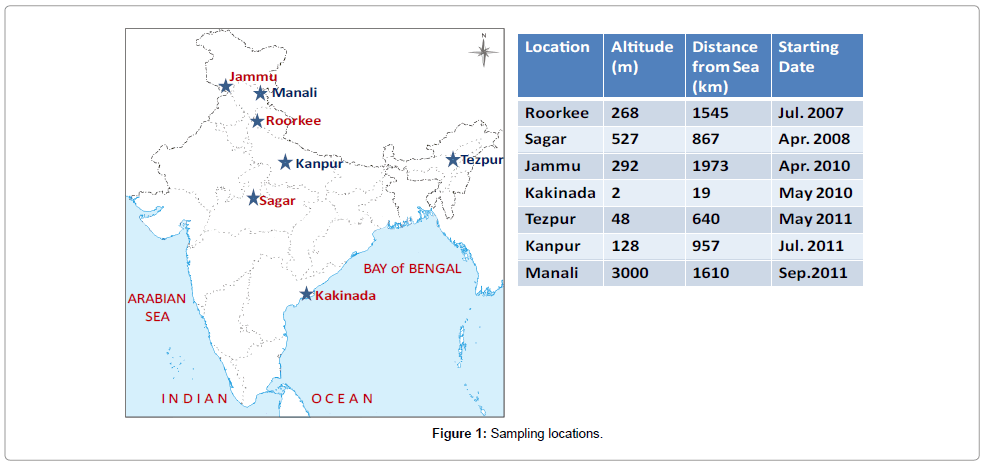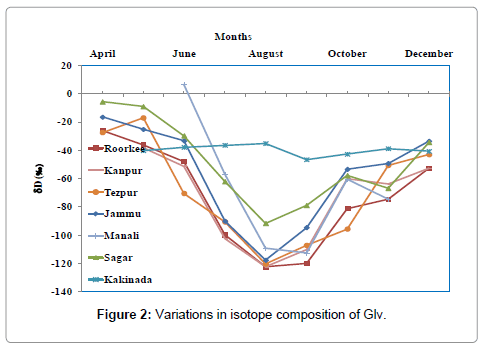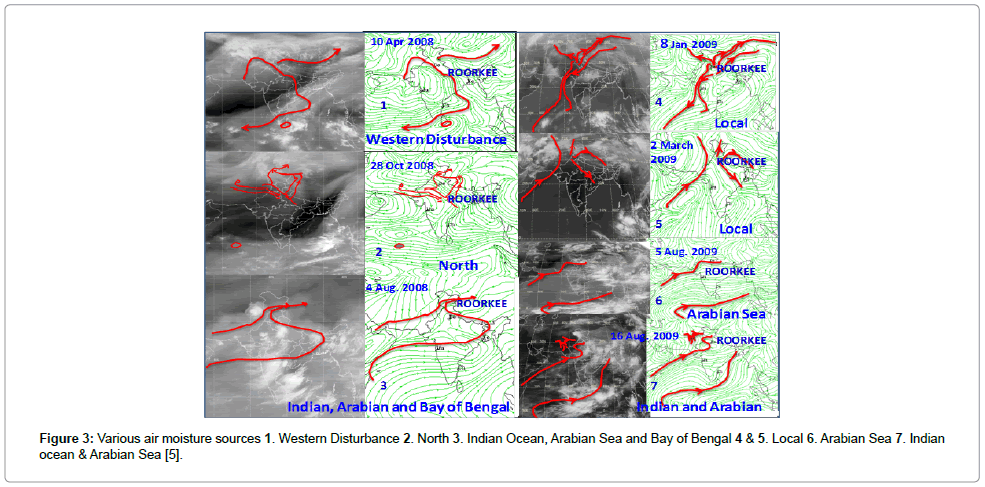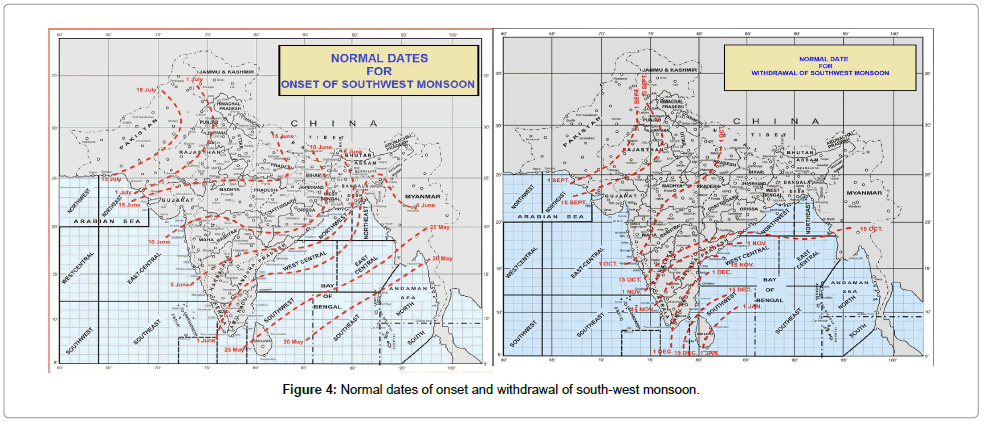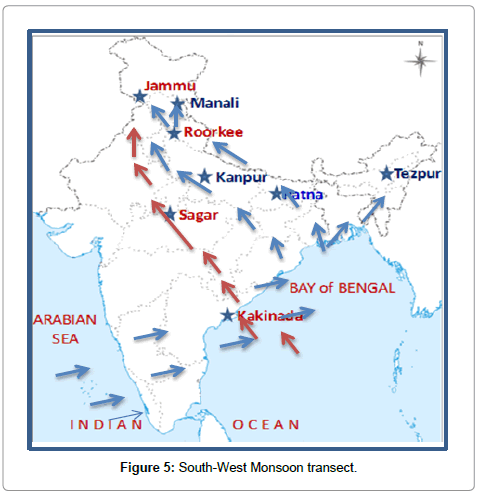Monitoring of Southwest Monsoon Using Isotope Analysis of Ground Level Vapour (Glv) in Indian Sub-Continent
Received: 29-Sep-2014 / Accepted Date: 29-Sep-2014 / Published Date: 07-Oct-2014 DOI: 10.4172/2157-7617.1000224
Abstract
This paper presents the work carried out by National Institute of Hydrology, Roorkee to understand the role of water vapor isotopes in understanding and monitoring the southwest monsoons. For this study, a network of stations was established all over India for collection of ground level vapor (Glv). The stations were established at Roorkee in foot hills of Shiwalik (Uttarakhand), Sagar in Central India (Madhya Pradesh), Jammu in Sub-Himalayan region (Jammu & Kashmir), Kakinada in coastal region (Andhra Pradesh), Tezpur in North-Eastern region (Assam), Kanpur in Gangetic plains (Uttar Pradesh) and Manali in Himalayan region (Himachal Pradesh).
A stronger isotopic depletion in the Glv with higher latitude, altitude, distance from coast and rainfall has been noticed which clearly indicate ‘latitude effect’, ‘altitude effect’, ‘continental effect’ and ‘amount effect’. The Glv received during the SW monsoon period is always depleted as compared to the Glv received during non-monsoon period in the continental stations and the extent of depletion in isotopic composition of Glv and period over this depletion continues is directly linked with monsoon strength (intensity, episodes and duration), showing a possibility of using isotopes to monitor movement of monsoon vapors.
Keywords: Southwest monsoon; Ground level vapour; Isotope analysis
6651Introduction
The applications of isotopic analysis of atmospheric air moisture in hydrology are already established by National Institute of Hydrology (NIH), Roorkee in various studies [1-9]. These applications are mainly based on the measurements of water isotopes on the principle that the lighter isotopes of water (e.g., H2O) preferentially evaporate over heavier isotopes of water (e.g., HDO or H2 18O), and heavier isotopes preferentially condense.
The southwest monsoon brings large amount of moisture on the Indian sub-continent during the period mid-June to September and in India, monsoon winds travel more than 2000 km from east coast of India to Northwest Himalayas before finally escaping into Pir Panjal. Earlier studies on monsoon dynamics [10-13] mainly relied on conventional meteorological parameters such as temperature (continental and sea surface), relative humidity, wind speed, wind direction, cloud pattern etc. However, sufficient accuracy in onset of monsoon, its dynamics on the continent and the timing of its withdrawal is not well understood. The complexity of the phenomenon is due to link between mixing of sub-regional moisture with continental scale moisture arising directly from Arabian Sea and/or Bay of Bengal and/or Indian Ocean. But due to the phenomenon of systematic depletion of atmospheric moisture and it’s recycling due to condensation and evaporation, it is possible to track the movement of air moisture.
This is for the first time in India, to establish southwest monsoon track, a network of stations was established all over India for collection of ground level vapor (Glv).
Materials and Methods
For collection of Glv, the stations were established at Roorkee, (2008) in foot hills of Shiwalik (Uttarakhand), Sagar (2008) in Central India (Madhya Pradesh), Jammu (2010) in Sub-Himalayan region (Jammu & Kashmir), Kakinada (2010) in coastal region (Andhra Pradesh), Tezpur (2011) in North-Eastern region (Assam), Kanpur (2011) in Indo-Gangetic plains (Uttar Pradesh) and Manali (2011) in Himalayan region (Himachal Pradesh) as per the details shown in Figure 1.
Identical procedure of sample collection by condensation method is followed at all the stations [7,14]. The air moisture samples, for isotopic analyses, are collected one sample per day on daily basis from 9.30 am to 10.00 am by condensation method. The time is preferred 9.30 am to 10.00 am due to (i) the relative humidity is usually higher compared to that in the afternoon. The higher the humidity, the greater will be the volume of liquid condensate collected in a given time. (ii) the temperature around this time is comparatively lower, and therefore, condensation is more and evaporation from the collected liquid is less. (iii) the melting of ice cubes in the aluminium cone is minimal and therefore, condensing efficiency of the cone does not change drastically over an hour or so during the sampling period.
The location of the sampling is kept fixed for all the study period. The condensation device was kept in a Stevenson screen at a height of 1 meter from the ground level.
The samples were analysed for stable isotope (2H or D) in water using GV-Isoprime Dual Inlet Isotope Ratio Mass Spectrometer [14]. The daily isotope values for all the stations were averaged on monthly basis for the period April to December due to (i) at the station Manali, due to heavy snowfall the sampling was possible only for this period (ii) the month and year of establishment of all the stations was different as per the details given in Figure 1.
The details of meteorological parameters of the sampling stations is given in Table 1.
| Sr. No. | Location | Average Temperature (°C) | Average Relative Humidity (%) | Annual Rainfall |
|---|---|---|---|---|
| (mm) | ||||
| 1 | Kakinada | 29 | 74 | 1458 |
| 2 | Sagar | 26 | 52 | 1279 |
| 3 | Manali | 13 | 71 | 1364 |
| 4 | Jammu | 24 | 73 | 1193 |
| 5 | Tezpur | 25 | 79 | 1809 |
| 6 | Kanpur | 24 | 66 | 881 |
| 7 | Roorkee | 23 | 78 | 1156 |
Table 1: Meteorological parameters of the sampling locations.
Results and Discussion
In the present study, a stronger isotopic depletion in the Glv with higher latitude, altitude and distance from coast i.e. continental effect has been noticed which clearly indicate ‘latitude effect’, ‘altitude effect’ (generally, 1-4‰ depletion in δD values per 100 m) and ‘continental effect’ (generally 2‰ depletion in δD values per 100 km) (Figure 2). These effects were earlier recorded in the precipitation and now these can be deciphered in atmospheric water vapour samples also. The order of depletion in the δD values was in the following order Roorkee>Kanp ur>Tezpur>Jammu>Manali>Sagar>Kakinada.
During monsoon season (June to September) over the Indo-Gangetic plains (Roorkee, Kanpur, Sagar, Jammu, Tezpur) moist winds blow in Southwest direction. The change in wind pattern occurs from winter to the onset of monsoon during which the Himalayan winds blow over the Indo-Gangetic plain in the Northeast direction. The changing wind direction is expected to affect isotopic composition of moisture, temperature and absolute humidity.
Similarly, the more depleted δD values observed in all the continental stations except Kakinada during mid-monsoon period indicated an ‘‘amount effect’’ on Glv phase stable water isotopes. The ‘amount effect’ has already been indicated in the precipitation samples on Global scale and Asian scale by Rozanski et al. [15] and Vuille et al. [16] respectively.
Southwest monsoon dynamics is a large scale phenomenon and local effects do not influence much, otherwise, we should have observed these effects in our data. Since, major source of moisture at all the stations is due to combination of Bay of Bengal, Arabian Sea and India Ocean (Figure 3) coupled with relative distance from these sources; similar isotopic results may be expected at all the places. Minor local effects do show deviation during southwest monsoon at these stations. The data is prone to be affected by local variability and therefore, we have used monthly average data. As per IMD, New Delhi (Figure 4) there is a difference of more than 15 days in the time of onset and withdrawal of monsoon at these stations.
Figure 3: Various air moisture sources 1. Western Disturbance 2. North 3. Indian Ocean, Arabian Sea and Bay of Bengal 4 & 5. Local 6. Arabian Sea 7. Indian ocean & Arabian Sea [5].
Conclusion
A stronger isotopic depletion in the Glv with higher latitude, altitude, distance from coast and rainfall has been noticed which clearly indicated ‘latitude effect’, ‘altitude effect’, ‘continental effect’ and ‘amount effect’.
The specific depleted values of δD of Glv during SW monsoon period and the extent of its depletion is directly linked with monsoon strength and is helpful in tracking movement of monsoon vapors and hence the South-West monsoon transect was established (Figure 5).
The Glv received during SW monsoon period is always depleted as compared to the Glv received during non-monsoon period in the continental stations and the extent of depletion in isotopic composition of Glv and period over which this depletion continues is directly linked with monsoon strength (intensity, episodes and duration), showing a possibility of using isotopes to monitor movement of monsoon vapors.
The isotopic spectra grossly correlate in most part of the spectrum. This clearly indicates that although rainout process take place locally, its effect on the atmospheric water vapours can be observed over long distances and this opens up possibility of monsoon prediction through monitoring of atmospheric water vapour.
The success of the present study, which focuses on observations from multi-stations provide rapid communication of the new idea and new technology in the atmospheric dynamics. However, taking long term data correlation can verify the philosophy and results of the paper but that would further establish the conclusion drawn.
Although the isotopic composition is area specific but as the changes in the regional weather at one parts of the country may affect moisture flow in other part of the country the relative and dependent effects may be observable through micro investigations as provided in the present paper.
Acknowledgements
Authors thank Director, National Institute of Hydrology for his constant support. Dr. Gopal Krishan thanks Dr. Alan MacDonald and Dr. Helen Bonsor, BGS-UK for all the support and encouragement. The funding received from Department of Science and Technology, New Delhi (July, 2007-June, 2013) and BGS-DFID, UK from (July, 2013 –September, 2014) is highly acknowledged.
References
- Krishan G, Rao MS, Kumar B (2012a) Study of climatological conditions using isotopic signature of air moisture at Roorkee, Uttarakhand, India. NDC-WWC J 1: 5-9.
- Krishan G, Rao MS, Kumar B (2012b) Application of Isotopic Signature of Atmospheric Vapor for Identifying the Source of Air Moisture-An Example from Roorkee, Uttarakhand, India. J Earth Sci Climate Change 3: 1-5.
- Krishan G, Lohani AK, Rao MS, Kumar CP, Kumar B, et al. (2013a) Studying Dynamics of the South West Monsoon in Indian Sub-Continent through Geospatial Correlation of Isotopes in Air Moisture. J Geol Geosci 3: 1-3.
- Krishan G, Rao MS, Kumar CP, Kumar B, Thayyen RJ (2013b) Using Stable Isotope (dD) of atmospheric water vapour in southwest monsoon studies. NDC-WWC J 2: 18-20.
- Krishan G, Rao MS, Jaiswal RK, Kumar B, Kumar CP (2013c) Southwest (SW) monsoon dynamics study in Indo-Gangetic plains using isotopic techniques. J Geol Geosci 2: 1-4.
- Krishan G, Rao MS, Kumar CP, Kumar B (2014a) Isotopic Observations from Two Stations of North India to Investigate Geographical Effects on Seasonal Air Moisture. J Earth Sci Climate Change 5: 1-6.
- Krishan G, Rao MS, Kumar CP (2014b) Isotopes analysis of air moisture and its application in hydrology. J Climatol Weather Forecasting 2: 1-5.
- Rao MS, Krishan G, Kumar B, Anitha M, Kumar KB, et al. (2012) Stable Isotope Systematics of Atmospheric Vapour at Hyderabad and Roorkee. Int J Earth Sci Eng 5: 1123-1128.
- Rao MS, Krishan G, Kumar CP, Tripathi S, Kumar B (2013) A Pre feasibility study of isotopes for investigation of monsoon dynamics. NDC-WWC Journal 2: 5-9.
- Derek B, Worden J, Noone D (2008) Comparison of atmospheric hydrology over convective continental regions using water vapor isotope measurements from space. J Geophys Res 113.
- AjayaMohan RS, Goswami BN (2003) Potential Predictability of the Asian Summer Monsoon on Monthly and Seasonal Time Scales. Meteorol Atmos Phys 84: 83-100.
- Gadgil S, Sajani S (1998) Monsoon precipitation in the AMIP runs. Climate Dynamics 14: 659-689.
- Shukla J (1987) Interannual variability of monsoon, in Monsoons. Fein JS, Stephens PL (edn), Wiley and Sons, New York 399–464.
- Krishan G, Rao MS, Kumar B (2011) Instrumentation for measurement of isotopic composition of air moisture. J Instrument Soc India 41: 217-220.
- Rozanski K, Araguas-Araguas L, Gonfiantini R (1993) Isotopic patterns in modern global precipitation, in Climate Change in Continental Isotopic Records. Geophys Monogr Ser 78, (edn) Swart PK, Lohmann KC, McKenzie J, Savin S. AGU, Washington DC, USA 1-37.
- Vuille M, Werner M, Bradley RS, Keimig F (2005 ) Stable isotopes in precipitation in the Asian monsoon region. J Geophys Res 110.
Citation: Krishan G, Rao MS, Kumar B, Kumar CP, Kumar S, et al. (2014) Monitoring of Southwest Monsoon Using Isotope Analysis of Ground Level Vapour (Glv) in Indian Sub-Continent. J Earth Sci Clim Change 5: 224. DOI: 10.4172/2157-7617.1000224
Copyright: ©2014 Krishan G, et al. This is an open-access article distributed under the terms of the Creative Commons Attribution License, which permits unrestricted use, distribution, and reproduction in any medium, provided the original author and source are credited.
Share This Article
Recommended Journals
Open Access Journals
Article Tools
Article Usage
- Total views: 18178
- [From(publication date): 10-2014 - Apr 03, 2025]
- Breakdown by view type
- HTML page views: 13559
- PDF downloads: 4619

